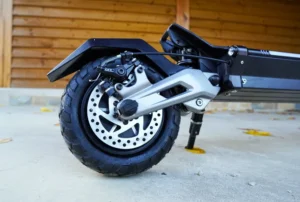In the realm of eco-friendly transportation, electric scooters have gained immense popularity, and at the heart of their silent and efficient operation lies a crucial component – the electric scooter battery.
This article aims to unravel the mysteries surrounding electric scooter batteries, exploring their types, technologies, and the evolving landscape of energy storage in the world of urban mobility.
Types of Electric Scooter Batteries
- Lithium-Ion (Li-ion) Batteries: The most prevalent choice in electric scooters, Li-ion batteries strike a balance between energy density, weight, and lifespan. They offer a lightweight and efficient power source, making them ideal for the compact design of electric scooters.
- Lead-Acid Batteries: While less common in modern electric scooters due to their weight and limited energy density, lead-acid batteries are still used in some budget-friendly models. They are known for their affordability but come with the trade-off of bulk and shorter lifespan.
- Nickel-Metal Hydride (NiMH) Batteries: NiMH batteries are less common in electric scooters, but they offer a middle ground between Li-ion and lead-acid batteries in terms of energy density and weight. However, advancements in Li-ion technology have largely overshadowed NiMH in recent years.
Key Battery Technologies and Considerations
- Energy Density: A crucial factor influencing the range of an electric scooter, energy density refers to the amount of energy a battery can store per unit of volume or weight. Advancements in energy density contribute to longer rides on a single charge.
- Charging Speed: Fast-charging capabilities are becoming increasingly important for electric scooter users. Lithium-ion batteries, in particular, excel in this aspect, allowing for quick pit stops to top up the battery and continue the journey.
- Cycle Life: The number of charge and discharge cycles a battery can undergo before its capacity significantly diminishes is known as cycle life. Lithium-ion batteries generally have a longer cycle life compared to lead-acid batteries, contributing to their popularity.
- Battery Management Systems (BMS): BMS plays a crucial role in protecting the battery from overcharging, overheating, and other potential issues. A robust BMS ensures the safety and longevity of the battery.
Emerging Trends and Innovations
- Solid-State Batteries: Research and development in solid-state battery technology aim to overcome the limitations of traditional Li-ion batteries, offering improved safety, energy density, and lifespan.
- Swappable Batteries: Some electric scooter models now feature swappable batteries, allowing users to easily replace a depleted battery with a fully charged one, eliminating the need for lengthy charging stops.
Conclusion
The electric scooter battery is the powerhouse behind the smooth and sustainable glide of modern urban commuting.
As technology continues to evolve, we can expect further innovations in battery technology, leading to more efficient, lightweight, and eco-friendly solutions.
Understanding the nuances of electric scooter batteries empowers users to make informed choices and contributes to the ongoing revolution in urban mobility towards a greener and cleaner future.



